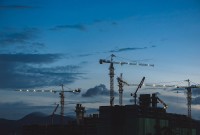- Home
- Business Processes
- Industry Knowledge
- Aerospace Industry
- Automotive Industry
- Banking Domain
- BFSI Industry
- Consumer/ FMCG Industry
- Chemicals Industry
- Engineering & Construction
- Energy Industry
- Education Domain
- Finance Domain
- Hospitality Domain
- Healthcare Industry
- Insurance Domain
- Retail Industry
- Travel and Tourism Domain
- Telecom Industry
- Leadership Skills
- eLearning
- Home
- Industry Knowledge
- Engineering & Construction
- Challenges in Construction Industry
Challenges in Construction Industry
In spite of the steady rise of the construction industry and its demand, it remains heavily dependent on manual labor. The construction industry faces challenges that become even more for developing countries. Some key challenges are poor productivity, inflation, and rising costs, availability of skilled labor and increased competition, and shrinking profit margins.
Given below are the top challenges being faced by the construction firms:
1. Impact of Technology
With the knowledge explosion, the technology is changing at a phenomenal rate and new technologies are emerging at even faster rates with greatly reducing productive life spans. The technologies and skills of human resources are becoming obsolete rapidly. It is now essential that even the professionals in the field must continuously upgrade and update their knowledge base and managerial skills. The focus of the twenty-first century will be on learning new skills.
The twenty-first century will be the century of liberal economy and global marketing. The quest for a better quality of life for its every citizen will necessitate a quantum technological push. The local construction industry is poised to face very stiff competitive challenges from current market players and multinational concerns. It has to strive for better quality, higher productivity, maximum efficiency, and competitiveness not only to progress and expand but even to maintain its present state and survive. The keywords for progress and even for existence will be "QUALITY" And "EXCELLENCE".
The industry is also moving toward less traditional models such as design-build, in which the same construction company completes both the design and construction of the project and seeking ways to conserve natural resources and become more environmentally friendly.
2. Modern Organizational Structures
Construction projects require a huge investment of resources. The productive and effective management requires a very innovative, creative, and efficient organizational structure to manage the financial, technological end human resources within the constraints of time, cost, quality, and availability. The construction industry has certain specific characteristics, vastly different from other industries. 'These must be studied and analyzed before any attempt is made to develop the organizational model for it.
3. Lack of Skilled Management
Most of the work on construction is carried out with mobilization and other advances given by the owner. The capital investment required for setting up a construction firm is negligibly small. The requirement of experience for getting registration is almost non-existent. Thus, almost anybody who has an access to some capital is encouraged to enter the construction business, without any requirement of skill and or professional knowledge and experience. Most of these firms have no commitment to the construction profession or patience to acquire the required managerial skills. Their motivation to enter into the construction business is only to earn fast bucks without any regard for ethics or quality. It is, therefore, not surprising that according to statistics, construction firms are at the top of the list of business failures and bankruptcies.
4. Lack of Availability of Labour Force
The bulk of the labor force engaged in construction is seasonal and migratory employed on a piece-rate basis. They are primarily committed to agriculture giving precedence to it over everything else during certain periods and climatic conditions in a year. During the rest of the year, they are engaged as construction labor for intermittent short durations; Very often the family is the unit of employment. They do not consider their involvement in construction as a vocation and thus have a commitment to the profession and have little aptitude and motivation to assimilate and improve upon the required knowledge and skill of the chosen trade. The piece rate of the mode of payment also encourages the workers to put long hours of work and take large risks at the cost of health and safety, Workforce lives near the worksite where the adequate provision of sanitary facilities and housing are not provided as a rule rather than exception in-spite of contract provisions in the stipulated rules and labor laws. There is no availability of medical facilities, insurance, and pension/provident fund benefits, In general, the employment pattern and working conditions are drastically different and primitive in construction as compared with other industries.
5. Bureaucracy
Many Government, and Seri-government agencies like Municipal Committees, Corporations, Area Development Authorities, Urban and Rural Planning, and Development Agencies, Town and Country Planning Boards, Mining Department, Forest Department, Safety Inspectors, Fire Department, Labour Department, Director of Industries, local Police and Administration, Sales Tax, Income Tax and Excise Department, various other Public Departments and the similar never-ending plethora of controlling authorities required to issuing clearance certificates, controlling various aspects of construction at each project site. It is estimated that at a typical construction site, the construction manager is expected to deal with a minimum of twenty-two different inspectors and fill at least two dozen different returns quarter yearly and to attend to the whims of a large number of agencies.
6. Safety Hazards
The construction, at the project site, is highly accident-prone. The accident rate in the construction industry is at least four times higher than that in any other industry. The construction consists of work executed from temporary structures and semi-finished stages, e.g. scaffoldings, staging, and falsework attached to and supported by permanent structures that are at various stages of erection and completion. The progress of the execution of these operations is continuously transforming the machinery and equipment (facility) layout and working environment. None of the safety precautions and safeguards adopted in permanent and "long-term" factories can be applied to construction sites. The working environment at these construction sites (temporary factories) is much more hazardous and straining due to the rapidly changing character of work sites, uncertainties of the natural environment, and fluctuating levels of beat, light, and sound. This is in complete contrast with the working conditions and controlled environment of manufacturing and other industries.
According to a survey in Ontario, Canada, the loss due to accidents in a particular year to the construction industry in Canada was more than the total profit of all the contractors in Canada in that year. It is, therefore, imperative that a safe environment and hence, the safety precautions and safeguards must be very carefully and exhaustively studied, researched, and strictly enforced at the construction sites. Enough is not done in this area either by concerned government departments or by larger firms in the construction industry.
Construction Industry Development Council (CIDC) and National Institute of Construction Management and Research (NICMAR) efforts are also not sufficient in this field
7. Manpower/Labour Quality
The construction industry offers many types of jobs and positions for all types of workers, those with degrees, those without, skilled workers, and unskilled workers. Degreed professionals in the industry typically work as architects, engineers, project managers, or site managers. These professionals may also be part of sales and marketing or other jobs such as advertising, human resources, and accounting that are part of every company. Non-degree workers or those with associate degrees or certifications may be hired as design technicians or assistants, site supervisors, customer relations or service representatives, materials coordinators, or similar positions. Skilled workers must usually complete formal training or an apprentice program and they typically focus on a specific trade such as brickwork or masonry or welding. Unskilled workers are hired as laborers on construction sites to operate equipment and provide the physical labor needed.
The basic necessity of work quality is the quality of its human resource, particularly at the operative level. Labor productivity is largely dependent on the quality of labor force available in given geographical area. Widely scattered and varied construction projects undertaken by a construction firm make it necessary to employ the local labor to a very large extent barring some very specialized trades. Workers, thus, follow the availability of job opportunities in the area and constantly change their employment.
Their loyalty and commitment are more towards their local/community leader and labor contractor as compared to their actual employer.
Another important aspect of labor quality in construction is ‘learning by doing, the process of training, and acquirement of skills. The different methods of doing the same work and different methods of achieving the same goal are learned either by imitation or trial and error techniques at actual construction sites. One's perceptions of work methodology are changed, modified, reinforced, or defined by subsequent experiences. The pooling of knowledge and skill of a group of persons (gang) can provide more choices and options in problems at sites. Thus, in the absence of any rational and organized apprentice training and skill formation program, the quality of construction, labor force available in an area will be isolated to the local level of work activity in a particular trade.
The major cause of poor quality and productivity in the construction sector is the scarcity of skilled manpower. As said earlier, it is much easier to find contractors in our country than to find a good mason or concreter. This is primarily due to the total absence of apprentice training programs in construction-related trades.
8. Productivity of Industry
The productivity of the construction industry is at a very low level as compared to other industries. Statistics show that in the decade of the 70s, the increase in construction productivity was a minimum of at0.8% as compared to 5.4% for public utilities, 4.6% for transportation, and 24% of all industries taken s an average.
Several reasons can be assigned to the cause of low productivity in the construction sector; Haber and Levinson in their study have categorized them into the following two broad categories:
(a) Supply characteristics, and
(b) Demand characteristics.
The supply characteristic includes the immobility of construction projects, less than optimal working conditions, and the diversity of products. On the demand side, the construction industry is subjected to heavy fluctuations in demand (seasonal and cyclic). But the single most important reason for low productivity is the scarcity of trained and skilled human resources at a level of management from CEO to operatives.
The need for a better level of technology and practice, systematic planning and work programming, and effective management is therefore self-evident. Higher quality human resource is needed far wide-ranging aspects to be taken into account, e.g. site investigation, market survey, bidding for works, mode of construction, supervision, and control of man, material, equipment, and finance, monitoring the progress of execution, providing necessary controls of time, cost and quality, designing, implementing and maintaining an effective management information system from conceptualization to completion of the project end its subsequent maintenance during the stipulated period, settlement oaf contractual obligations and disputes and the realization of outstanding dues, These problems are magnified many times in recently introduced new concepts of contracting, e.g. OT, BOOT and BOO in the infrastructure sector.
The system productivity of the construction industry can thus be considered as a complex interaction of the following three productivity factors:
(a) Planning,
(b) Designing, and
(c) Performance(execution}.
The system management can thus be looked upon as a process of coordinating and communicating the entire project process of feasibility, design, planning, scheduling, contracting, executing, and controlling with the objects of maximizing system productivity (e.g. minimizing cost and duration).
Related Links
You May Also Like
-
Roles in Construction Industry
In general, there are various groups of stakeholders involved in a construction project. Each group contributing a specific component, examples are the owner group, the engineering group, and the construction group. In this article, we take a look at different roles that exist within the ambit of the construction industry.
-
Construction Industry – Business Model
The business model for the construction industry tells the story about how the industry works, defining who the target customers are, how the business makes money, and what the customer values. Most of the construction projects originate by clients as concepts of public or private utility, and actually delivered by many players in the industry.
-
Construction Industry – The Sectors
The construction industry produces a wide range of products, and the enterprises working in the construction domain are equally diverse. The construction industry can be divided into three sectors of construction namely building, infrastructure, and industrial. They can be further classified as residential, non-residential, and engineering projects. The construction activity can be carried out as a private or public endeavor.
-
Challenges in Construction Industry
In spite of the steady rise of the construction industry and its demand, it remains heavily dependent on manual labor. The construction industry faces challenges that become even more for developing countries. Some key challenges are poor productivity, inflation, and rising costs, availability of skilled labor and increased competition, and shrinking profit margins.
-
Construction Industry in India
India is one of the world's fastest-growing construction markets, rising at the rate of 7-8 percent annually. By 2025, India will become the third-largest market in the world, thereby becoming a key driver for the Indian economy. The Indian construction industry employs over 30 million people and creates assets worth over ₹ 200 billion. Indian Construction Industry consists of 200 firms in the corporate sector.
-
Features of Construction Industry
Construction projects (activities) have some unique features with respect to other industrial projects. The construction industry is a unique industry with its own inherent complications that involves multiple stakeholders and agencies. Dependent on contractors and seasonal labor-force it has multiple linkages with other industries. Productivity and safety hazards are peculiar to this industry.
-
Importance of Construction Industry
The construction industry is an important part of the country's economy. Construction is an important sector that contributes greatly to the economic growth of a nation. The construction industry has laid down the physical and technological foundations upon which modern civilization has developed. It also creates investment opportunities across various related sectors and vital to the achievement of national socio-economic objectives.
-
Overview of Construction Industry
Construction is the oldest and one of the largest industries in the world with its market size of about ten trillion US dollars. Construction is traditionally a contracting business right from the good old days, the industry comprises of a very large number of small firms. Now the construction industry is one of the largest industries in any economy. It makes a significant contribution to the national economy and provides employment to a large number of people.
Explore Our Free Training Articles or
Sign Up to Start With Our eLearning Courses

About Us
Learning
© 2023 TechnoFunc, All Rights Reserved








